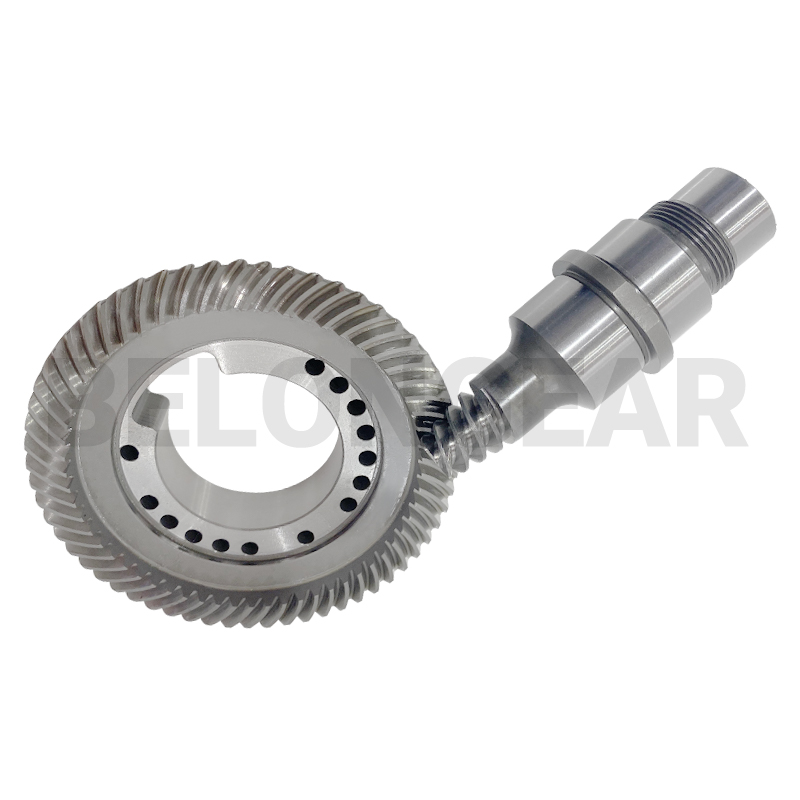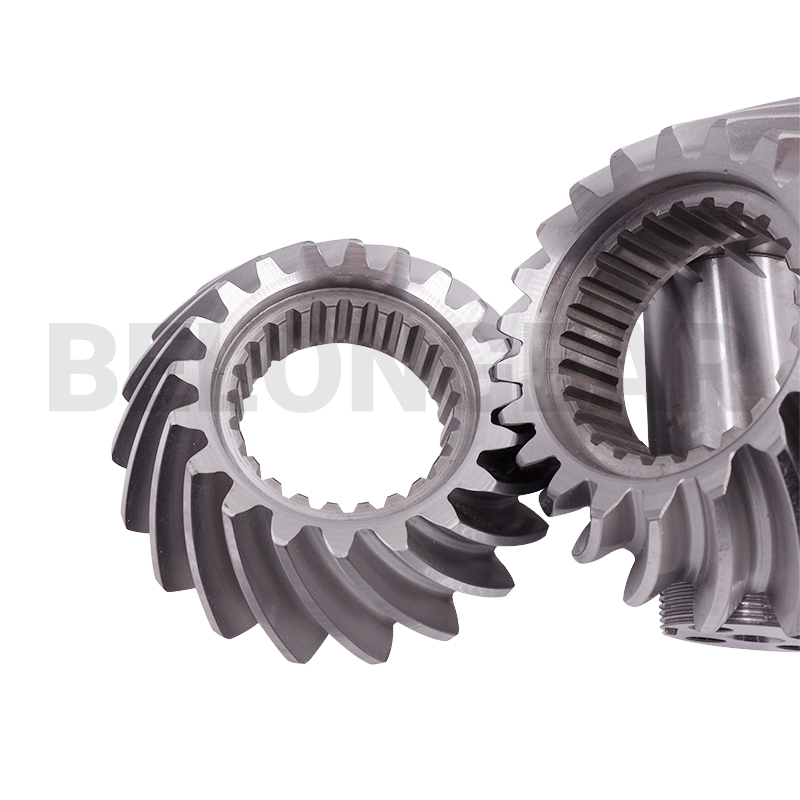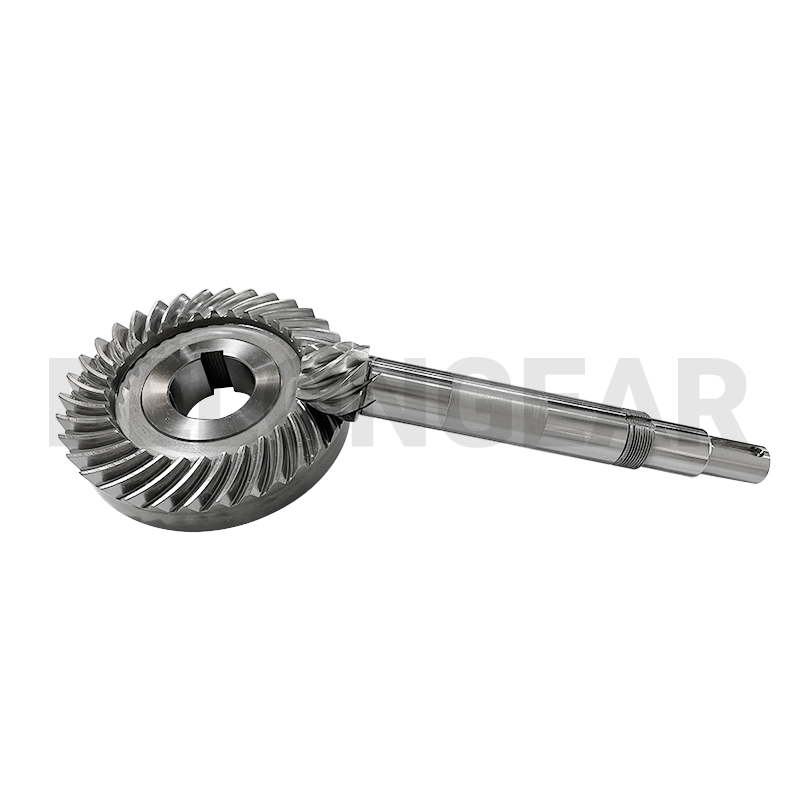Usually you may hear different methods by machining bevel gears, which includes straight bevel gears, spiral bevel gears, crown gears or hypoid gears.
That is Milling, Lapping and Grinding. Milling is the basic way to do the bevel gears. Then after milling, some customers choose lapping, some customers choose grinding. What’s the difference ?

Lapping belongs to a finishing, the most important purpose of research teeth is to noise reduction and improve the surface contact of the gear tooth. Lapping is a finishing method for correcting the fine tooth errors and improves surface quality. Due to the error caused by the cutting milling or heat treatment deformation of the previous step, the meshing accuracy is lowered, the purpose of the teeth is to escape the contact surface of the wheel to improve the smooth rolling characteristics of the rotten tooth, ensure the wheel tooth quietly, improve the bearer ability.

Lapping is a very small amount of metal cutout process, which is completed by the speed and force associated with the opposite to the tooth surface. At least the dentist requires that noise reduction, the degree of noise reduction is different depending on the process teeth process parameters and the gear sub initial conditions. The improvement of the tooth to noise can be measured by a variety of precision pulse level. The research tooth also requires no load capacity of the gear pair, from another angle, that is, the initial contact zone of the teeth do not destroy the wheel, it is best to effectively improve the rotating contact zone.

Although lapping cannot be accurately modified to the gear pair like the grinding method, improve the accuracy level of the gear, but through the appropriate location point residence control technology, torque real time control technology, etc. , or can effectively improve the rotating contact zone. For example, according to the process requirements, the tooth surface drum shape in the teeth or tooth longity is increased, and the tooth surface contact zone is smaller in contact length, position and deflection state.
Reasons for Lapping
1. The cost of dentation is low, the equipment price is relatively low, and it is obvious to reduce the noise effect;
2. The spiral cone gear to teeth is to be used, but the tooth surface of the large wheel and the small wheel is best.
3. After the teeth are the gear heat treatment, the two gears are ground to each other, such gears do not destroy the hard shell surface, and the teeth are uniform, ensuring the life of the gear;
4. For the entire transmission system of the automobile, the main speed of the automobile (last transmission) is not significant after using grinding tooth, because the transmission system on the transmission system, such as the transmission, and all over the transmission system. The accuracy of the unit is not too high;
5. Even with imported materials, the heat treatment is used to use the research to lapping, and the manufacturing cost is not higher than the grinding.
Grinding: The heat treatment deformation is eliminated after hardened tooth surface, and further improve the gear precision and improve the roughness of the tooth surface, and is still mainly based on the grinding process.
Requirements For Gear Teeth Before Grinding
1. Railing balance should be uniform
Due to the deformation after the gear carbon quenching, the accuracy should fall by 1-2 levels, and the grinding should be corrected, so the size of the gear retaining margin should be the maximum deformation of the gear after carburizing quenching. Sure. In general, the maximum variation is mainly related to the thermal process ability of the material, the heat treatment process, the structure of the gear and the geometry of the geometry, so the remaining amount should be considering the above factors.
2. The gear must have a certain roof in the root root, and there are three reasons:
2. 1 From the grinding process, it is required to have a certain root cut in the root to play a role of the blade.
2. 2 After the gear is quenched, the residual stress of the gear is compressive, which is very advantageous to improve the bending strength of the gear, and the grinding root will turn the residual stress of the surface to pull the stress, which will make the wheel tooth The anti-bending strength is reduced by about 17-25%.
2. 3 From the bending strength of the wheel, it is required to have a certain root of the root of the gear. If there is no root of the root root, the step of the root will generate steps, which will result in larger The stress concentration, which seriously affects the anti-bending ability of the gear.
3. 3 Asymptom length of the rear gear
It should be long enough, because the root is rooted, it is possible to make the grinding length of the gear after the grinding of the gear, resulting in a decrease in the weight of the gear, thereby generating vibration and noise during the meshing process, and also reduces the load carrying capacity of the gear. Therefore, the grinding gear should have a sufficiently long progressive line to ensure smooth operation of the gear.
Advantages Of Grinding
1. For spiral gears and quasi-bib gears, grinding can achieve interchangeability, no longer need to be used, and the gears of the teeth must be used, so that some costs can be resilible;
2. Grinding can improve the accuracy of the gear, improve the accuracy of the transmission, and the lapping can only increase the surface roughness of the gear;
3. Grinding can save many products that cannot be bore, reduce many waste losses;
4. For many domestic steels, there is no requirement, resulting in excessive deformation after heat treatment, using the grinding process to correct this impact, and the research teeth cannot achieve this effect;
5. Gear manufacturers who introduced grinding technology in China have achieved very good economic benefits; many advanced spiral cone gear production enterprises have used grinding processes:
6. With the improvement of grinding efficiency, the increase in production batch, the manufacturing cost will be greatly reduced
Summarize
It is undeniable that grinding is slower than lapping and more expensive than lapping.
For example, a pair of cone gears require two grinding machines, each gear requires two minutes; the lapping are also required for two minutes, but only one lapping machine is required. In addition, the grinding machine’s grinding cost is triple the cost of the lapping machine’s lapping cost.
However, waste rates and consumer complaints applied to specific areas are only 1% or less, while the lapping products reach 3-7%. Waste gears contain the cost of all processes, but also add material fees, so in consideration of waste rates, grinding has better economy.
Just five years ago, the two processing methods were very different in cost, more conducive to the teeth, but today, research shows that with the development of machine tool technology, the production of new grinding wheel abrasives, semi-finishing strategy Application and many other achievements have been achieved, and the molars have a very bright future, making it a very attractive processing method.
Post time: Mar-11-2022




